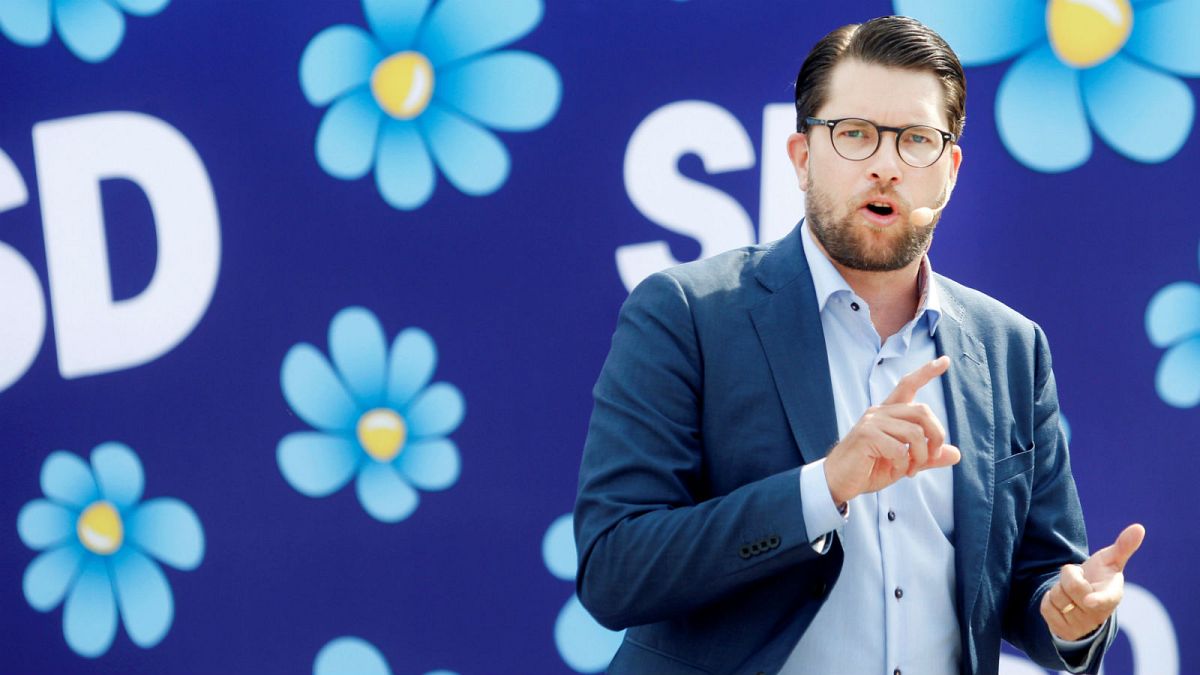Sweden had a record-breaking 163,000 asylum applicants in 2015. Will the legacy of this be the country electing far right populists Sweden Democrats on September 9?
Swedes are heading to vote in a new government on September 9 and it’s shaping up to be historic.
Here is our guide on what you need to know.
Why should I care about Sweden’s election?
Like elsewhere in Europe in recent times the prospect of a sharp turn towards populism is looming over this election.
It comes in the shape of Sweden Democrats: polls have predicted the right-wing nationalists could get up to 28.5% of the vote.
If the party wins some form of power it could see a shift in its relationship with Brussels and a weakening of the union.
There is also the prospect of climate change issues entering the political fray for the first time in Sweden, according to experts, who say the country’s recent spate of wildfires has pushed global warming up the political agenda.
Who are the key runners and riders?
Social Democrats: The main player in Sweden’s current centre-left coalition and the party of Prime Minister Stefan Lofven. It is the juggernaut of Swedish politics and has been the biggest party in elections for a century. But is that all about to change?
Moderate Party: The centre-right movement — which favours job creation and lower taxation — ousted the Social Democrats in 2006 and had an eight-year spell in power.
Sweden Democrats: The populist anti-immigration party, led by the smartly-dressed Jimmie Akesson, is on course for its best-ever election showing. If it gets around 25% of ballots, as some opinion polls have suggested this summer, it would continue a quirky trend of the party doubling its vote share at each election.
Green Party: The environmentalists tasted power for the first time when they got into bed with the Social Democrats four years ago to form a minority coalition government. Will it suffer as a result of its time in power or benefit from climate change becoming a more prominent issue since the country’s wildfire-splattered summer?
Other parties: There is the liberal and pro-rural Centre Party; the anti-EU and former communist movement the Left Party; the Liberals; the Christian Democrats; the Feminist Initiative; and the neo-Nazi Nordic Resistance Movement.
What do the opinion polls say?
Polling over the summer has put the ruling Social Democrats on as low as a 21% vote share - down 10% on its showing at Sweden’s last parliamentary election in 2014 and the party’s worst showing for more than a century.
“When we talk about about Sweden and other Scandinavian countries you associate them with social democracy,” Patrik Öhberg, an expert on Swedish politics from the University of Gothenburg.
“But it seems like this era is going to end now. We have become more a country like everyone else. It’s a bastion of social democracy now maybe going to rubble. Something big is going on here.”
The main beneficiary of the centre-left’s slump has so far been the far right Sweden Democrats, who some surveys have predicted will pick up 28.5% of the vote, more than double its performance four years ago before the peak of Europe’s refugee crisis.
Why is Sweden set to back the far right more than ever before?
The country has relatively low unemployment; its wealth-per-person is above the EU average; and it’s in the top ten happiest countries in the world.
Sweden, arguably, has never had it so good.
So why are Swedes poised to give the established parties a bloody nose and back the burgeoning Sweden Democrats?
“People vote for Sweden Democrats for one reason and one reason only: immigration,” said Öhberg.
For Sverker Gustavsson, a political scientist from Uppsala University, the reasons run deeper.
“The Swedish economy is working very well at the moment and unemployment is lower than in most other countries,” he said.
“But it is about something else: it is to do with discontent and a raising of expectations that politics does not deliver what people think it should deliver.
“The important thing is — and it’s like the Brexit tendency in Britain or Trump in the US — people do not feel at home culturally, they doubt that we are on the right track.”
Why is immigration such a big issue?
It is a legacy of Europe’s refugee crisis in 2015 when Sweden received a record-breaking 163,000 asylum applicants.
Up until that point the country of 10.1 million people had been a beacon of liberalism in Europe by being so open to refugees.
But that all changed amid the influx of three years ago when the country’s asylum applications per capita were the second highest in the EU.
It saw Sweden’s minority government perform a dramatic u-turn, putting up temporary border checks and tightening the rules for future arrivals.
While that may have stemmed the flow, it was not enough to save the credibility of the ruling Social Democrat-Green Party coalition, according to Öhberg.
“For such a long time they said: ‘This [immigration] is not an issue, you’re racist, we should not talk about it, it’s a win-win,” Öhberg told Euronews. “Then suddenly they have to say ‘Oh, we were wrong’.”
“Immigration is super important and we are talking more and more about it. People are more and more concerned. For such a long time the issue was dismissed or the laws were made more liberal.”
Is there a link between immigration and crime?
Sweden might be committed to integrating refugees into society — there is even a website to help new arrivals — but there are some troubling statistics on how effective efforts have been so far.
For example the unemployment rate among Swedes was 4.4% last year, compared with 15.3% among its foreign-born nationals, according to Statistics Sweden.
In addition the country’s gun murder toll has gone up sharply in recent years, hitting an 11-year high in 2017, with 43 deaths.
There is no suggestion this has anything to do with Sweden’s 2015 asylum seeker influx but organised crime and violence is acknowledged to be a problem in the immigrant-heavy suburbs of Sweden’s major cities.
The same areas have also seen an increase in the number of hand grenade attacks as well as a spate of car fires in recent months.
“There are problems with burning cars, shootings and so on in Stockholm, Gothenburg and Malmo,” said Professor Gustavsson.
“But you shouldn’t exaggerate it because in an international context it’s not so dramatic. But it is in a Swedish context because we have not had this kind of thing before.
“To some extent [there is a link between violent crime and immigration] of course. It’s something to do with the fact it’s difficult to integrate all the newcomers but it’s extremely exaggerated because we’ve integrated a lot of refugees from the Balkan wars in the 1990s and up to a couple of years ago the consensus was we were very successful at it.
“But now the whole scene has changed to look upon each shooting in order to put the argument that we should never have allowed so many immigrants in.
“On the left the attitude has been that the Swedish welfare state needs in the long run a lot of young people in order to manage it.”
How have the election campaigns going?
It has been a story of two fires, so far, according to Öhberg.
The environmentally-friendly parties saw a spike in support after Sweden’s outbreak of wildfires over the summer, putting climate change on the electoral agenda.
But each time there is a car blaze voters swing towards Sweden Democrats, who come out and claim it shows the government has lost control of the suburbs, he added.
What is the likely outcome?
While the gains of Sweden Democrats have attracted the headlines, experts say the prospect of them governing is slim.
This is mainly because parties on the left and right refuse to work with them, according to Professor Gustavsson.
“What is now so obvious is that the parties both on the right and especially the left side do not trust these people in the Sweden Democrats to the extent they could make agreements,” he told Euronews
The most likely outcome, added Professor Gustavsson, is either more of the same, a Social Democrat-Green Party coalition, or a minority Moderate Party government that would seek support from other parties on specific issues.
What could be the impact on the European Union?
Sweden Democrats want a referendum on EU membership but it may have to concede ground in this area to make a coalition possible with the pro-Brussels Moderate Party.
“If you look at the opinion polls the attitude towards the EU is more popular,” Öhberg said. “But the Left Party and Sweden Democrats want us to leave.
“But if they get a combined 30% I don’t think that would change much. But we would have a stronger force in Sweden for Swexit.
“I don’t think it’s likely at all but then I didn’t predict Trump and I didn’t think the Sweden Democrats would get this big, so who I am to tell you?”


